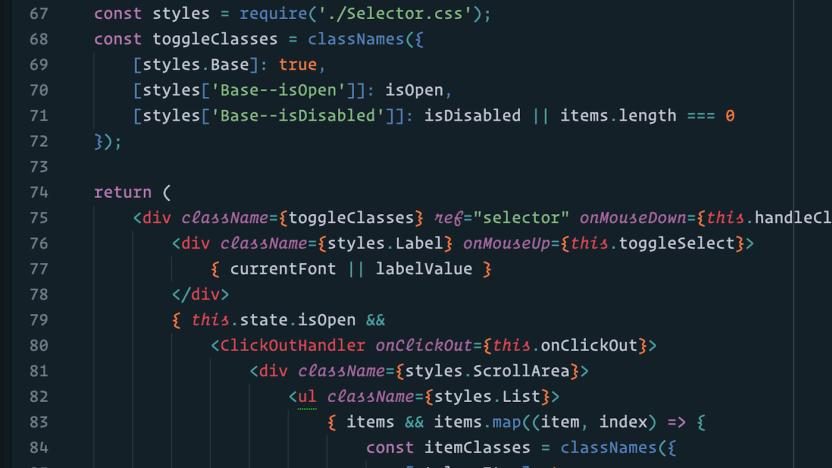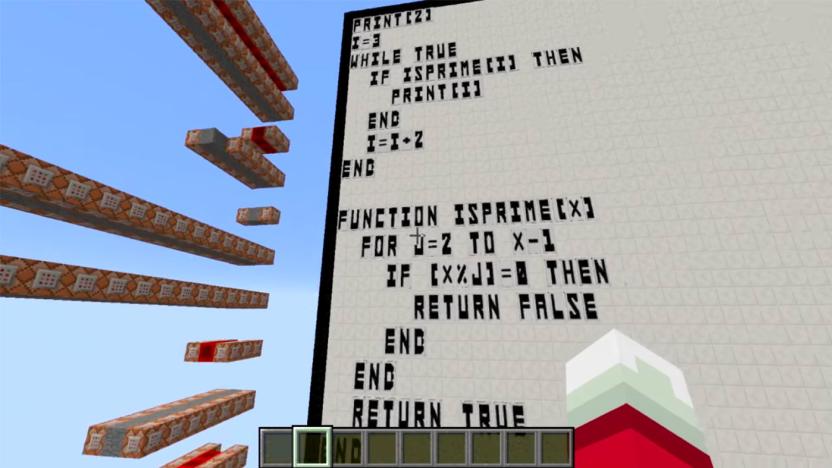code
Latest

'Operator' is a font designed to make coding easier
While many of us bristle at the sight of Comic Sans (this writer included), coders have an altogether different view of typefaces and how they're presented. Thus, Operator Mono, the new font from one of the highest-regarded typeface-creators that was forged to make life easier for the folks who build the websites you visit. "In developing Operator, we found ourselves talking about Javascript and CSS," founder Jonathan Hoefler writes. While the blog post about typography and font faces can come off as a bit pretentious, it's clear that the team paid attention to how the likes of brackets, commas and semicolons are spaced and how they appear in back-end coding environments.

Donald Trump gets his own blustery programming language
Have you ever wondered what code would look like if it were dictated by a presidential candidate's grandiose statements rather than such radical concepts as accuracy and logic? No? Well, you're going to find out regardless. Rice University students Chris Brown and Sam Shadwell have created TrumpScript, a Python-based programming language that takes Donald Trump's philosophy a little too literally. For a start, it won't deal with either floating point numbers or any number smaller than 1 million -- America doesn't do anything halfway or deal with the small stuff, you see. It also won't allow users from China or Mexico (you can't even use import statements), insists on ending programs with "America is great" and refuses to admit to most of its failures.

'Minecraft' fan finds a way to program BASIC code in-game
You may have seen Minecraft used to teach programming or even mods that allow some in-game programming, but writing BASIC code inside Minecraft? That's virtually unheard of... until now. SethBling has developed a BASIC interpreter that lets you compile and run simple programs and scripts within Mojang's world-building game. It boils down to using many, many command blocks, but it really works. You can not only print text, but have in-game robots ("turtles") perform tasks. Need to dig a long tunnel? Just start a digging script and let the bot do all the hard work.

Google uses Pixar's 'Inside Out' to teach girls programming
If you've ever toyed with the idea of learning to code, the process can be a little daunting: there a dozens of languages, thousands of variables and few newbie-friendly places to get started. Google's Made with Code project is one of many organizations dedicated to changing that -- and the group's latest effort to make programming fun leans heavily on the appeal of Disney magic: specifically, Pixar's Inside Out.

Microsoft uses 'Minecraft' to teach your kid how to code
You can get kids to do a lot if you promise them Minecraft... just ask parents who've watched their children race through chores to get some building time. And Microsoft knows this, too. It just released a tutorial for Code.org that uses Minecraft to teach the basics of computer programming. Instead of pointing and clicking to smash your way through the landscape, you construct a string of commands using code-like snippets such as "turn left" and "destroy block." This hopefully shows your young ones how programming can be both fun and relevant -- it's not just some boring thing you do to make money. Many students will try this when the next Hour of Code kicks off on December 7th, but you can visit the website today if your kids can't wait to give it a shot.

Watch code and projections bring a paper sculpture to life
Paper art doesn't have to be flat and lifeless... just ask Aristides Garcia. The artist recently created an interactive sculpture, Tesela, that uses a combination of 3D projection mapping and tesselation algorithms to cast real-time, viewer-influenced patterns over 103 paper pyramids. The effect is a bit hypnotic, as you'll see below -- it's as if the paper has suddenly become a living landscape. You sadly can't see this in person at the moment (Garcia debuted it at a Berlin exhibit in August), but it still shows that the right technology can liven up just about anything, even if it's made from dead trees.

Google's codebase is ludicrously huge for good reason
Google's codebase -- the programming instructions that run every one of its services from Gmail to Slides -- span a whopping 2 billion lines of code that stretch across 1 billion files and require 86 terabytes of storage, according to Google engineering manager Rachel Potvin. She recently disclosed those figures at the @Scale engineering conference. She also noted that this massive collection of data is mirrored and continually updated in ten data centers peppered around the globe. "Not only is the size of the repository increasing," Potvin explained during her lecture, "but the rate of change is also increasing. This is an exponential curve."

Animated code art uses all of its colors just once
You probably know that the screen on your computer or phone can display millions of colors, if not more. However, have you wondered what it would look like if you tried to represent all of those colors in a single piece of art? Well, you're looking at it. Qubit researcher and math guru Mike Swarbrick Jones has posted a code-driven animation that shows all the colors in a 24-bit RGB palette exactly once. The technique (which relies on mapping colors to voxels, or 3D pixels) produces a kind of "rainbow smoke" that, as you can see in the clip below, is rather hypnotic -- it's tempting to watch it on a loop and meditate. While this won't produce a masterpiece, it's proof that a good idea and the right calculations can lead to some truly eye-catching (not to mention mind-bending) visuals.

Google's been recruiting programmers based on their search habits
Want a job slinging code for Google? You might already be on the company's radar. According to new Google hire Max Rosett, he never applied for a job at Google -- the company reached out to him after he made a habit of using Google search as a programming resource. One day, a search for "python lambda function list comprehension" returned something unexpected: a secret Google recruitment test.

Dear Veronica: Real-Life Trek Tech?
#fivemin-widget-blogsmith-image-123624{display:none;} .cke_show_borders #fivemin-widget-blogsmith-image-123624, #postcontentcontainer #fivemin-widget-blogsmith-image-123624{width:570px;display:block;} try{document.getElementById("fivemin-widget-blogsmith-image-123624").style.display="none";}catch(e){} Summer is in full swing now, which means that parents are trying desperately to figure out what to do with their errant teenagers. How about teaching them to code? There are lots of options out there, and I cover some of my favorites in this week's episode. Plus, we get to hear about what technologies from Star Trek are actually possibly from my favorite space nerd Phil Plait, a.k.a. The Bad Astronomer! We also need your photos or videos of the worst catastrophes your phones have survived through! Post them to social using the #DearVeronica hashtag, along with your questions for future episodes!

Artist paints a 328-foot-long line of code at Twitter's building (updated)
Qinmin Liu, the tech-savvy artist who offered replica kidneys in exchange for gold Apple Watches, is back with a new project -- and this one is every bit as audacious and full of social commentary as her last. She recently finished painting a line of code (translated into binary) on a 328-foot scroll of paper in the same building as Twitter's San Francisco headquarters. The piece took 10 days to complete at a solid 8 hours per day, and virtually dominated the hallway.

Weaponizing code: America's quest to control the exploit market
When the US Bureau of Industry and Security published how it plans to implement the sections on hacking technologies in a global weapons trade pact called the Wassenaar Arrangement (WA) last week, it ignited an online firestorm of meltdowns, freakouts, and vicious infighting within the most respected circles of hacking and computer security. That's because the new rules change the classification of intrusion software and Internet Protocol (IP) network communications surveillance -- setting in motion a legal machine that might see penetration-testing tools, exploits and zero-days criminalized. Some suggest the new classifications also seem designed to give the US a market advantage over the buying, selling, import and export of certain tools used in cyberwar -- a currently black market, in which the US government is already the biggest player.

Apple could be delaying HomeKit by a couple months (Update: Nope)
Citing sources close to the project, Fortune reports that Apple plans to delay the release of its much anticipated HomeKit platform. While the company has never actually provided a firm release date, it's been widely speculated that HomeKit would hit sometime mid-summer, around June or July. Now it would appear that users will have to wait until August or September to begin smartening up their homes. Fortune's sources blame rapidly bloating code for the delay. Apparently, the current programming iteration demands far too much memory from smaller IoT devices and Apple figures it will need an extra month or so to trim the code down to more functional specs.

MIT's light-up robot garden teaches you how to code
If you're teaching kids how to code, what do you do to show that software makes an impact in the real world? MIT has a clever idea: a robot garden. The project lets you control a grid of Arduino-linked "plants" through programming that makes them blossom and light up in pretty (and occasionally mesmerizing) ways. It'll even teach the virtues of distributed computing -- you can tell these leafy robots to bloom or change color in algorithm-driven sequences. The garden is just a demo for now, but it'll eventually turn into an easy-to-replicate curriculum for students who'd otherwise have to settle for seeing their results on-screen. [Image credit: Jason Dorfman, CSAIL]

'Doctor Who' coding game for kids arrives on tablets
You no longer have to fire up your computer just to give your children some programming lessons from Doctor Who. The BBC's educational coding game, The Doctor and the Dalek, is now available on iPads and Android tablets (both through Amazon and soon Google Play). You'll get largely the same instruction-based Boolean logic puzzles as before, but with a few new levels and new abilities for your one-of-a-kind Dalek companion. The catch? While the game is still free, it's only available in the UK for now -- here's hoping that the BBC makes it available worldwide so that more kids can help their favorite Gallifreyan.

The US Army wants you to look at code it uses to spot cyberattacks
Believe it or not, the US government doesn't always keep its cyberwarfare code a secret. The Army Research Lab has quietly posted the source code for Dshell, a tool it uses to both spot and understand cyberattacks against the Department of Defense. The hope is that this open-door policy will not only help other countries and companies defend against hackers, but help improve the US military's own safeguards -- if you have a knack for digital security, you could spot flaws or offer improvements.

City of Titans explains its prototyping process
The developers behind City of Titans haven't been shy about praising the Unreal Engine 4 at the heart of development. A new design article gives some insight into one of the major elements of design that makes it so useful to the team, a feature that offers rapid progress between brainstorming, prototyping, and testing: blueprints. While the article doesn't contain the nuts-and-bolts of the programming elements, it demonstrates how the team was able to build and test a tile-based map system (akin to Skyrim) as an independent element to be tested. The result is that instead of spending a great deal of time brainstorming the idea, the team can drop the prototype in for testing and it can be evaluated as an actual option instead of simply a theory. Take a look at the full article for more details on the map system and the test process. [Thanks to Byron for the tip!]

Porn studios' copyright takedowns are making it hard to find code
Aggressive anti-piracy efforts often have their share of unintended victims, but the porn industry's crackdowns are leading to some decidedly unusual collateral damage: open source software. TorrentFreak notes that copyright takedown requests from studios like Wicked Pictures are removing Google search results for GitHub code projects whose names are only vaguely similar to adult movies, or even the studios' names. Among the casualties are Facebook's Rebound (a spring physics add-on), Netflix's Lipstick (workflow visualization) and OpenSUSE Linux's Wicked (a network setup tool).

DARPA funds $11 million tool that will make coding a lot easier
DARPA is funding a new project by Rice University called PLINY, and it's neither a killer robot nor a high-tech weapon. PLINY, named after Pliny the Elder who wrote one of the earliest encyclopedias ever, will actually be a tool that can automatically complete a programmer's draft -- and yes, it will work somewhat like the autocomplete on your smartphones. Its developers describe it as a repository of terabytes upon terabytes of all the open-source code they'll find, which people will be able to query in order to easily create complex software or quickly finish a simple one. Rice University assistant professor Swarat Chaudhuri says he and his co-developers "envision a system where the programmer writes a few of lines of code, hits a button and the rest of the code appears." Also, the parts PLINY conjures up "should work seamlessly with the code that's already been written."

GitHub's free student bundle gets you started on writing code
It's harder to score student discounts on programming tools now that many of them are subscription services, but GitHub has just launched a bundle that could make it far less expensive to get cracking. Its new Student Developer Pack gives you free access to the kind of tools you'd typically need to get a serious coding project off the ground, including the Unreal game engine, cloud hosting and GitHub's own code repository service. How much you get for free varies. Some partners simply offer credit, while others will give you a subscription -- in a few cases, for as long as you're still a student. The hope is that you'll like the tools enough to pay for them later, of course, but it's hard to knock an offer that leaves you with fewer school-related bills.







